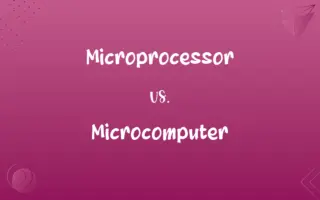Static Memory Allocation vs. Dynamic Memory Allocation: Know the Difference

By Shumaila Saeed || Updated on February 20, 2024
Static memory allocation assigns memory at compile time, while dynamic allocation does it at runtime.

Key Differences
Static Memory Allocation occurs when the size and lifetime of a data structure are determined at compile time. In static memory allocation, the memory size is fixed and cannot be altered at runtime. Dynamic Memory Allocation involves allocating memory at runtime using pointers. Dynamic memory allocation allows the size of data structures to be modified during the execution of a program.
Shumaila Saeed
Feb 18, 2024
Static memory allocation simplifies memory management as the compiler automatically handles it. Dynamic memory allocation, however, requires explicit management by the programmer using functions or operators.
Shumaila Saeed
Feb 18, 2024
Static memory allocation offers less flexibility compared to dynamic allocation. With dynamic memory allocation, programmers can request and free memory as needed during program execution.
Shumaila Saeed
Feb 18, 2024
Static memory allocation is more efficient in terms of memory access and management. Dynamic memory allocation is less efficient due to the overhead of managing memory at runtime.
Shumaila Saeed
Feb 18, 2024
Comparison Chart
ADVERTISEMENT
Flexibility
Less flexible, fixed memory size.
Highly flexible, memory size can be changed.
Shumaila Saeed
Feb 18, 2024
Memory Management
Managed automatically by the compiler.
Managed manually by the programmer.
Shumaila Saeed
Feb 18, 2024
Efficiency
More efficient in terms of memory access.
Less efficient due to runtime memory management.
Shumaila Saeed
Feb 18, 2024
Use Cases
Suitable for known, fixed data structures.
Ideal for data structures whose size changes at runtime.
Shumaila Saeed
Feb 18, 2024
Static Memory Allocation and Dynamic Memory Allocation Definitions
Static Memory Allocation
Memory allocation that is efficient for known, fixed data sizes.
Static memory allocation is more efficient for small, fixed-size data structures.
Shumaila Saeed
Jan 24, 2024
ADVERTISEMENT
Dynamic Memory Allocation
Memory allocation that typically occurs in the heap.
Objects created with 'new' in C++ use dynamic memory allocation.
Shumaila Saeed
Jan 24, 2024
Static Memory Allocation
Memory allocation with a predetermined size.
Arrays in C use static memory allocation.
Shumaila Saeed
Jan 24, 2024
Dynamic Memory Allocation
Memory that can be expanded or contracted as needed.
Dynamic memory allocation allows for resizable arrays in the program.
Shumaila Saeed
Jan 24, 2024
Static Memory Allocation
Memory that cannot be resized once allocated.
Static memory allocation doesn't allow resizing of memory during runtime.
Shumaila Saeed
Jan 24, 2024
Dynamic Memory Allocation
Memory allocation suitable for variable data sizes.
Dynamic memory allocation is essential for handling variable-sized data structures.
Shumaila Saeed
Jan 24, 2024
ADVERTISEMENT
Static Memory Allocation
Memory allocation that occurs during compile time.
Static memory allocation was used for the buffer as its size was known at compile time.
Shumaila Saeed
Jan 24, 2024
Dynamic Memory Allocation
Memory allocation that occurs during program execution.
Dynamic memory allocation is used when the data size is unknown until runtime.
Shumaila Saeed
Jan 24, 2024
Static Memory Allocation
Memory allocation that typically occurs on the stack.
Local variables are examples of static memory allocation.
Shumaila Saeed
Jan 24, 2024
Dynamic Memory Allocation
Memory allocation that requires explicit management.
Dynamic memory allocation requires the programmer to manually free memory.
Shumaila Saeed
Jan 24, 2024
Repeatedly Asked Queries
Is static memory allocation more efficient?
Yes, static memory allocation is generally more efficient than dynamic allocation.
Shumaila Saeed
Feb 18, 2024
When is static memory allocation used?
Static memory allocation is used when the size and lifetime of data are known in advance.
Shumaila Saeed
Feb 18, 2024
What is dynamic memory allocation?
Dynamic memory allocation is the allocation of memory at runtime, allowing variable size.
Shumaila Saeed
Feb 18, 2024
Can dynamic memory allocation change size during runtime?
Yes, dynamic memory allocation can change size during runtime.
Shumaila Saeed
Feb 18, 2024
Is dynamic memory allocation flexible?
Yes, dynamic memory allocation is highly flexible for varying data sizes.
Shumaila Saeed
Feb 18, 2024
Where does static memory allocation typically occur?
Static memory allocation typically occurs on the stack.
Shumaila Saeed
Feb 18, 2024
What is static memory allocation?
Static memory allocation is the allocation of memory at compile time with a fixed size.
Shumaila Saeed
Feb 18, 2024
How is memory freed in dynamic memory allocation?
In dynamic memory allocation, memory must be manually freed by the programmer.
Shumaila Saeed
Feb 18, 2024
What are examples of static memory allocation?
Arrays and static variables in C are examples of static memory allocation.
Shumaila Saeed
Feb 18, 2024
What is the main disadvantage of static memory allocation?
The main disadvantage of static memory allocation is its lack of flexibility.
Shumaila Saeed
Feb 18, 2024
Does dynamic memory allocation affect program performance?
Yes, dynamic memory allocation can affect performance due to its overhead.
Shumaila Saeed
Feb 18, 2024
Are global variables statically or dynamically allocated?
Global variables are statically allocated.
Shumaila Saeed
Feb 18, 2024
Can static memory allocation lead to wasted memory?
Yes, static memory allocation can lead to wasted memory if allocated more than needed.
Shumaila Saeed
Feb 18, 2024
Where does dynamic memory allocation occur?
Dynamic memory allocation occurs in the heap.
Shumaila Saeed
Feb 18, 2024
Can dynamic memory allocation cause memory leaks?
Yes, improper use of dynamic memory allocation can lead to memory leaks.
Shumaila Saeed
Feb 18, 2024
What programming languages use dynamic memory allocation?
Languages like C, C++, and Java use dynamic memory allocation.
Shumaila Saeed
Feb 18, 2024
Can static memory allocation handle variable data sizes?
No, static memory allocation cannot handle variable data sizes effectively.
Shumaila Saeed
Feb 18, 2024
How do you allocate memory dynamically in C++?
In C++, dynamic memory is allocated using the 'new' keyword.
Shumaila Saeed
Feb 18, 2024
What is heap fragmentation in dynamic memory allocation?
Heap fragmentation is a problem in dynamic memory allocation where memory becomes fragmented and inefficiently used.
Shumaila Saeed
Feb 18, 2024
Is static memory allocation suitable for large data?
Static memory allocation is less suitable for large, uncertain data sizes.
Shumaila Saeed
Feb 18, 2024
Share this page
Link for your blog / website
HTML
Link to share via messenger
About Author
Written by
Shumaila SaeedShumaila Saeed, an expert content creator with 6 years of experience, specializes in distilling complex topics into easily digestible comparisons, shining a light on the nuances that both inform and educate readers with clarity and accuracy.

































































